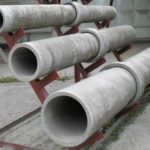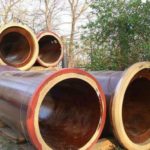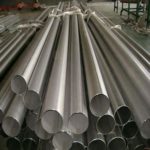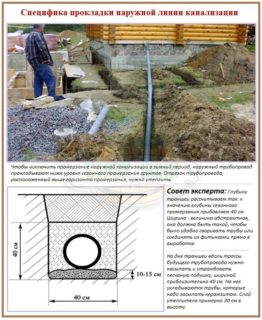It is very difficult to live comfortably without an autonomous sewage system in a private house: it takes a lot of time and effort to bring and carry buckets. In addition, there is no way to use modern household appliances - washing machines and dishwashers. Therefore, with great responsibility it is necessary to approach the selection and laying of pipes in order to ensure the drainage of drains from the house, as well as to arrange the supply of water to plumbing fixtures and equipment.
Actual requirements for laying sewer pipes in a trench
When laying an external sewage system, the following factors are taken into account:
- The estimated amount of wastewater that is planned to be passed through the system during the day. This includes the coefficient of uneven flows, since most of it comes in the morning and evening, when the whole family is at home and uses water and equipment. It is important to consider sediment runoff if the storm sewer is connected to the main septic tank. In this case, the diameter of the pipes should be calculated according to the largest volume.
- Septic tank filling speed. The number of people in the house is taken into account.
- Climatic conditions and sewerage depth. According to the rules of SNiP, pipes should be 30 - 50 cm below the freezing level of the soil, focusing on the upper edge of the product.
- Ground load - the highway is located in a private or urban pedestrian sector, under a motorway with low or heavy traffic. It follows from this that when arranging the sewage system, additional protective mechanisms should or may not be used - fittings, bases for pipes, stops.
- The presence of inspection wells at bends and difficult sections of the system with the ability to control.
- Sewerage type - gravity or pressure. The quality and strength of the pipes must correspond to the pressure level.
- The need for treatment facilities - sand traps, grease traps, grates, filters, sedimentation tanks.
- The final method of cleaning - on a private territory it can be an anaerobic septic tank, in an urban system - a biological treatment station using aerobic microorganisms with its own laboratory.
The rules were developed in 1985, but some provisions are still in effect. The norms for the arrangement of home systems, urban or rural public systems differ.
Selection of pipeline material
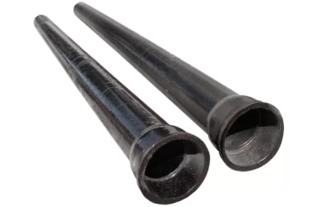
There are a large number of sewer pipes on sale, but this is difficult only for beginners who, for the first time on their site, are going to make gravity sewers.
Materials must meet the following criteria:
- have a smooth inner surface so that organic particles do not stick and do not create clogging;
- withstand the summer and winter temperatures characteristic of the region;
- be durable and durable;
- easy to install and, if possible, lightweight.
Stainless steel, cast iron of a new modification with a smooth inner wall, various polymers, black steel - the choice is large, but each material has its positive and negative sides, and is not always suitable for small country houses and small country houses.
Steel, cast iron or stainless steel
Bulky heavy structures are used more often for arranging urban sewerage systems. In this case, you can choose the most suitable material: there are 4 - 5 types of one cast iron. It serves for a long time, but if improperly laid, if the connection rules are violated, depressurization and leakage may occur.
Stainless steel and cast iron practically do not corrode, they are chemically inert, therefore the service life is from 50 to 80 years. The disadvantage of materials is that they are expensive, require high installation costs, as well as the involvement of equipment to lift a pipe that weighs about 100 kg.
Ceramics
The peculiarity of the material is that after firing the ceramic pipe gains strength, but if it is immersed inaccurately, the product will crack. On top of the pipes, they are covered with a special glaze to reduce the degree of exposure to chemical elements of the soil. They are connected using a resin substance and additional fittings. The disadvantage of ceramics is its high cost and fragility.
Asbestos cement, concrete
Concrete structures are a cheap material for installing sewerage systems, but they require high costs for laying in the ground due to the weight of the products. Concrete has a rough inner surface, so it is more suitable for storm sewers - organic matter will quickly settle on the walls and cleaning measures will be required.
Asbestos cement is a rather fragile material, therefore it is not used in places with a high load on the ground.
Polymers in sewers
- polyethylene of various types, differing in strength, resistance to temperatures and other factors;
- polypropylene, which is preferable in places where the drain temperature is higher - for example, when connecting a washing machine or dishwasher;
- polyvinyl chloride is the most suitable material for external sewerage, because it does not withstand high temperatures;
- fiberglass is a very durable material, but weighs more than products made from the above polymers.
Most often, PVC pipes are chosen, since they can be laid on the site on their own. The cost of laying a sewer pipe in the ground will be much lower.
Tools for assembling and laying sewer pipes
First of all, you need a grinder or a hacksaw for metal to cut plastic pipes with small teeth so as not to deform the edges.
To comply with the slope, you need to prepare a building level. A long rope will come in handy in order to dig a trench straight.
If the sewage system is cast iron or steel, a welding machine with appropriate solder is needed. Such a device is not required to connect the plastic.
Digging trenches is performed using an excavator or shovel, if the burial depth is not too great. A wooden device with a thickening at the end is used to tamp the sand cushion.
Technology for laying pipes in the ground
The first step is to designate the lines along which the pipe will be laid. Then, manually or with an excavator, they dig trenches of the required width and depth.
Laying technology:
- External sewerage is mounted from the foundation. If the joint of pipes of the internal and external sewage system is above the ground, it is necessary to isolate and insulate the area.
- Before joining, the ends of the pipes are closed with plastic bags so that dirt does not get inside.
- If you need to make a turn on the site, revision wells are equipped in such places for the convenience of cleaning and maintenance. It is best to use swivel fittings at a 45 or 30 degree angle so that drains can more easily pass through this section of the line.
- Be sure to check the slope of the pipe. For products with a diameter of 110 mm, you need to give 2 cm, for larger ones - 1 cm per linear meter. Pipes with a diameter of 50 mm are laid at a slope of 3 cm per meter.
- Silicone grease is used to facilitate joining of pipe ends and fittings. The connections are made by hand to the stop, making sure that no dirt particles get into the socket.
- It is recommended to immediately insulate the entire highway when laying, so that in the future you do not have to carry out excavations and finish the work. Insulation is purchased together with pipes. Particular attention is paid to those places where the flow rate is lower and there is a risk of water freezing in winter.
- After laying, a sand cushion is poured and tamped.
- The tilt angle is checked again, then the system can be tested. The internal and external sewers are connected and the water is turned on. If it flows into the septic tank, then everything is done correctly.
- The entire trench is covered with sand and excavated soil. Tamping is not carried out - this can lead to deformation of the line and a change in the angle of inclination.
At the same time, you can start digging a pit for a septic tank. After installing it and strengthening the walls, the end of the pipe is connected using a sealant or hot soldering.
It is advisable to carry out work on the laying of plastic sewage at temperatures above 7 degrees. Polypropylene, polyethylene and PVC do not tolerate cold well and become brittle.
Cost of work per running meter
The cost of laying one running meter of sewage depends on how the products are connected. For example, they collect plastic with their own hands, but cast iron, steel, concrete are heavier products, therefore, cranes are used during their installation, which is more expensive - the rent of special equipment and the work of a crane operator are paid.
The use of welding complicates the installation process. The device consumes electricity, which is also included in the cost of one running meter, plus the work of a welder. The more turns and changes in diameter, the more expensive the line will cost. What matters is the depth at which the work is carried out and the time spent by hired craftsmen.
If you carry out the entire installation yourself, then laying the sewer pipes in the trench will cost minimal costs.


